Introducing a new kitten to a dog can be a source of stress for both pets and their owners. However, with proper preparation and gradual introductions, you can help create a harmonious home for your furry friends. In this guide, I will provide step-by-step instructions on how to introduce a kitten to a dog without causing too much friction.
Before diving into the introduction process, it’s important to remember that each pet is unique, and the timeline for successful integration may vary. The key is to be patient and adapt as needed to ensure a smooth transition.
Key Takeaways:
- Prepare your dog by giving them extra attention and praise to show that the new kitten is not a threat.
- Create a safe space for your new kitten, separate from your dog, with all the necessary essentials.
- Allow your pets to get used to each other’s scents before any face-to-face interactions.
- Start with supervised meetings, keeping the kitten in a box and the dog on a leash, rewarding good behavior.
- Gradually increase the duration of their interactions and monitor their behavior closely, taking it slow to ensure a successful integration.
Prepare your dog for the new arrival
Before bringing a new kitten home, it’s important to prepare your dog for the arrival. Even if your dog has lived with other animals before, they may still need time to adjust. Give your dog lots of attention and praise to show that the new kitten is not a threat. Never leave them alone together in the early days, as dogs can potentially harm or even kill a kitten. It’s crucial to create a safe and secure environment for both pets during the introduction process.
To acclimate your dog to the presence of a new kitten, gradual exposure is key. Start by allowing your dog to sniff and investigate the kitten’s scent on an item like a blanket or toy. This can help your dog become familiar with the new scent and reduce any potential anxiety or stress. Repeat this process over several days before moving on to visual introductions.
During the initial introduction between your dog and the new kitten, it’s essential to keep both under controlled conditions. Use a leash for your dog and keep the kitten in a safe and secure space, such as a crate or separate room. Allow them to observe each other from a distance, gradually decreasing the physical barrier over time. This allows them to become accustomed to each other’s presence without direct contact. It’s important to closely monitor their behavior during these initial interactions and intervene if necessary to prevent any negative experiences.
| Preparing Your Dog for a New Kitten |
|---|
| 1. Give your dog attention and praise |
| 2. Never leave them alone unsupervised |
| 3. Gradually expose your dog to the kitten’s scent |
| 4. Use controlled introductions with a leash and a safe space for the kitten |
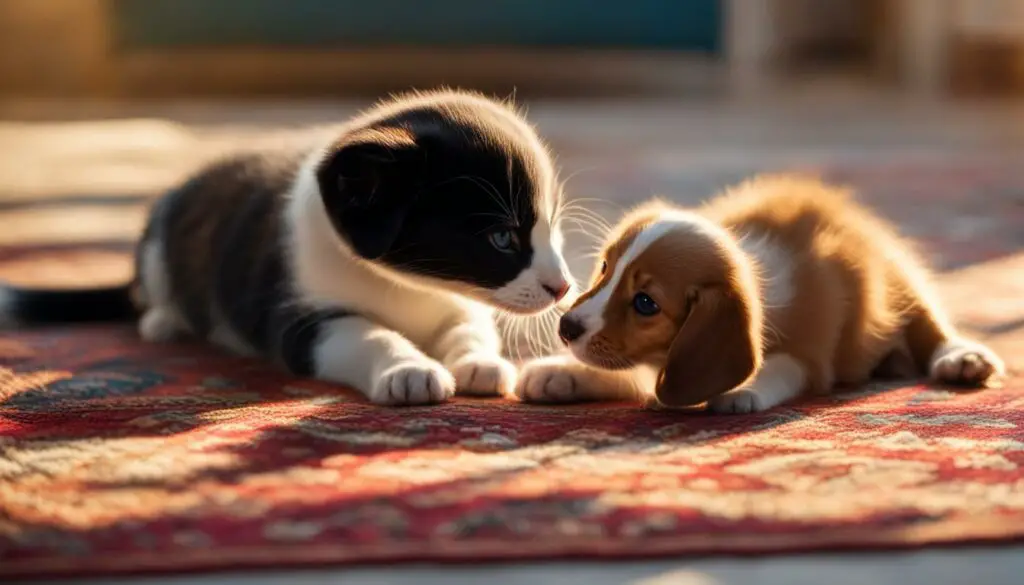
Remember, every pet is unique, and the introduction process may take time. It’s crucial to be patient and understanding throughout the process. If you encounter difficulties or concerns, seek guidance from a professional animal behaviorist or trainer who can provide personalized advice. By taking the necessary steps to prepare your dog for the arrival of a new kitten, you can help foster a positive and harmonious relationship between your pets.
Prepare a Safe Space for Your New Kitten
Creating a safe and comfortable space for your new kitten is an essential step in their successful introduction to your home. It provides them with a sense of security and allows them to explore and adjust at their own pace. To prepare a room for your new kitten, follow these steps:
- Clean the room thoroughly and remove any potential hazards that could harm the kitten.
- Set up a cozy bed or blanket for them to sleep on. Adding a familiar scent, such as a towel from their previous living environment, can help them feel more at ease.
- Place a litter box in a quiet corner of the room, away from their bed and food area. Ensure that the litter box is easily accessible for the kitten.
- Provide fresh water and food in separate bowls. Choose a high-quality kitten food that meets their nutritional needs.
By preparing a dedicated space for your new kitten, you allow them to gradually acclimate to their surroundings before introducing them to your dog or other areas of the house. This space provides a safe retreat for the kitten and allows them to establish a sense of ownership in their new environment.
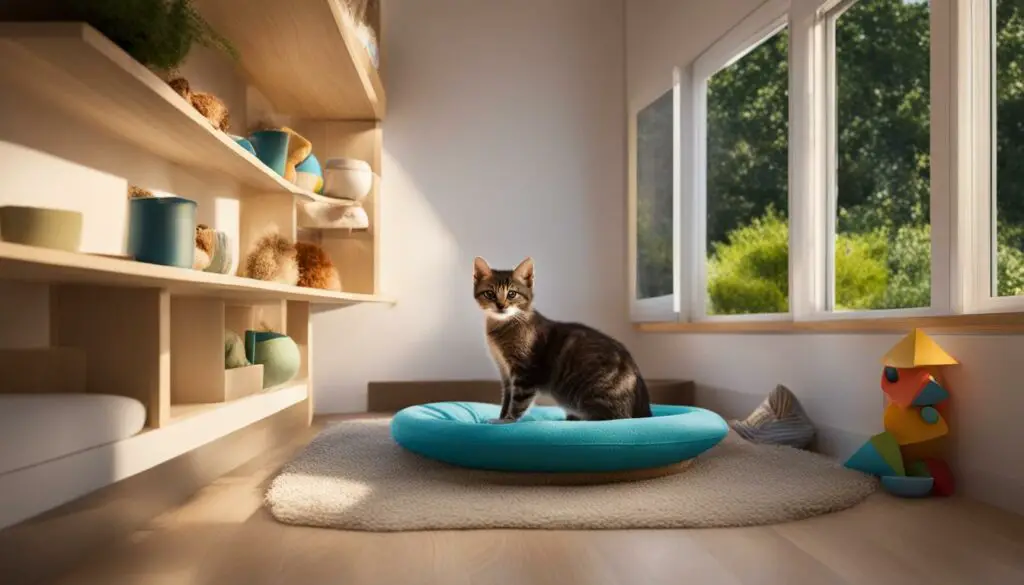
Creating a Safe Haven for Your Kitten
Creating a safe haven for your kitten is crucial for their well-being during the introduction process. It allows them to have a space of their own where they can retreat and feel secure. Here are some additional tips for creating a safe space:
- Provide toys and scratching posts to keep the kitten entertained and help fulfill their natural instincts.
- Ensure that the room is free from any potential dangers, such as open windows or toxic plants.
- Introduce the kitten to their safe space gradually. Keep the door closed initially, and allow them to explore at their own pace.
- Take the time to bond with your new kitten in their safe space, offering them love, attention, and gentle playtime.
Remember, the safe space should serve as a sanctuary for your kitten, where they can feel comfortable and secure. It allows them to adjust to their new surroundings and build confidence before venturing out to meet your dog.
Let them get used to each other’s scents
Before allowing the kitten and dog to meet face to face, it’s beneficial to let them get used to each other’s scents. This gradual introduction can help familiarize them with each other’s presence and reduce potential tension during future interactions. The goal is to create a positive association with each other’s smells, making the actual meeting more comfortable and less stressful for both pets.
One method to accomplish this is by feeding the kitten and dog on either side of a closed door. This allows them to smell each other’s food while associating it with positive experiences. Another approach is to swap their blankets or bedding, transferring their scents between the two animals. This scent exchange can help them become more familiar with each other before physically meeting.
During this process, it’s important to closely supervise their reactions and ensure that your dog doesn’t exhibit any intimidating or aggressive behavior towards the kitten. If any signs of aggression or discomfort are observed, it’s crucial to separate them and seek professional guidance if necessary.
| Benefits of Letting Pets Familiarize with Scents |
|---|
| Reduces tension during face-to-face introductions |
| Creates a positive association with each other’s smells |
| Helps the pets become more familiar with one another |
| Enables a smoother transition during the introduction process |

Familiarizing pets with scents
- Feed the kitten and dog on either side of a closed door.
- Swap their blankets or bedding to introduce their scents to each other.
- Supervise their reactions and ensure there is no aggressive behavior.
“Allowing pets to get used to each other’s scents before meeting face to face can greatly reduce tension and create a more positive introduction experience.”
Meeting for the first time
Now that your kitten and dog have become familiar with each other’s scents, it’s time to plan their first meeting. This initial interaction is crucial in setting the tone for their relationship. To ensure a smooth introduction, it’s important to take some precautions.
I recommend keeping the kitten in a box or carrier and the dog on a leash during the first meeting. This will prevent any unexpected reactions or potential harm to either pet. Make sure the dog is calm and relaxed before allowing them to approach the kitten. If the dog becomes too excited, it’s best to remove them from the room and try again later.
During the first meeting, closely observe the body language of both pets. Look for signs of fear, aggression, or tension. If any of these signs are present, it may be necessary to continue with supervised scent introductions and gradually work towards face-to-face interactions. Remember to reward both pets for good behavior with praise and cuddles.
| Signs of a successful first meeting between a kitten and dog | Signs of an unsuccessful first meeting between a kitten and dog |
|---|---|
|
|
Remember that every pet is unique, and their reactions may vary. It’s crucial to be patient and give them time to adjust to each other’s presence. If the first meeting doesn’t go as smoothly as you hoped, don’t be discouraged. It may take multiple attempts for them to feel comfortable together.
Tips for a successful first meeting:
- Keep the kitten in a box or carrier and the dog on a leash.
- Ensure the dog is calm and relaxed before allowing them to approach the kitten.
- Observe their body language for signs of fear, aggression, or tension.
- If the meeting is unsuccessful, continue with supervised scent introductions and try again later.
By following these guidelines and taking the necessary precautions, you can increase the chances of a successful first meeting between your kitten and dog. Remember, it’s important to prioritize the safety and well-being of both pets throughout the entire introduction process.
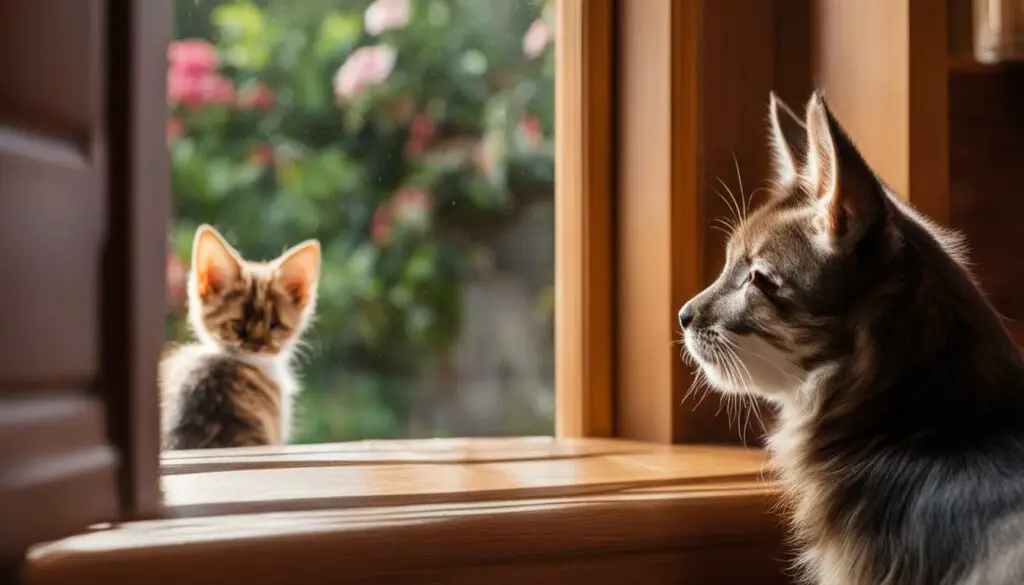
Moving on to further interactions
Once the initial introduction between the kitten and dog has been successful and they are comfortable being in the same room, it’s time to move on to further interactions. This phase is crucial for fostering a positive relationship between the two pets. Gradual, supervised play sessions will help them continue to build trust and familiarity with each other.
During these supervised play sessions, it’s important to ensure the safety of both the kitten and dog. Keep the dog on a leash to maintain control and prevent any rough behavior that may intimidate the kitten. Allow the kitten to explore and interact with the dog at their own pace. This will allow them to establish boundaries and gradually become more comfortable with each other’s presence.
Remember to remain calm and patient throughout this process. It might take several sessions before the kitten and dog start to play and interact more freely. Reward good behavior from both pets with praise and treats to reinforce positive associations. If either pet shows signs of stress or aggression, separate them and try again later. Taking it slow and allowing them to set the pace will help build a strong foundation for a harmonious relationship.
Key Points:
- Supervised play sessions allow the kitten and dog to become more comfortable with each other.
- Keep the dog on a leash during these interactions to ensure control and prevent intimidation.
- Allow the kitten to explore and interact with the dog at their own pace.
- Patience and positive reinforcement are key to building a successful relationship between the two pets.
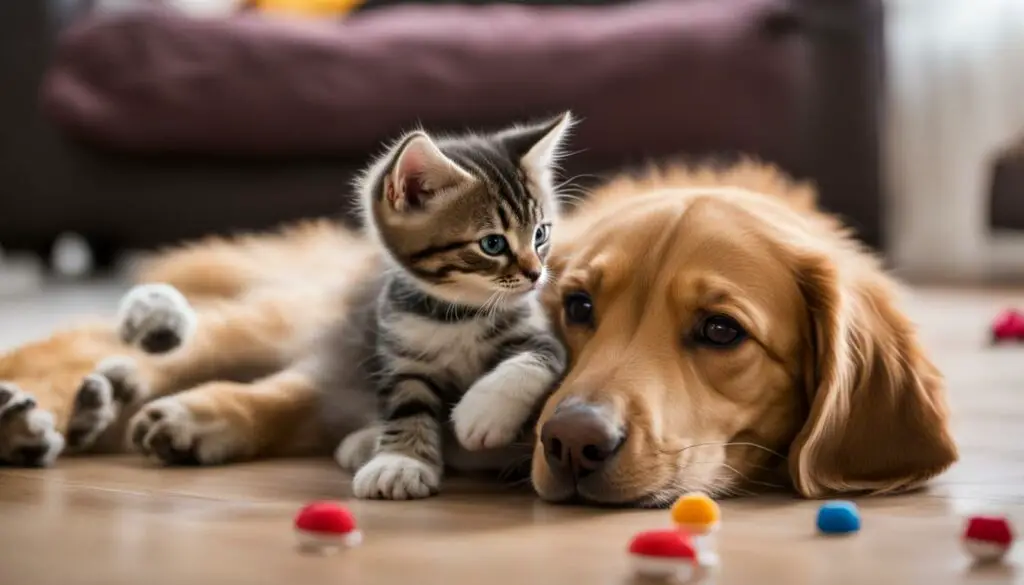
Table:
| Benefits of supervised play sessions | How to implement supervised play sessions |
|---|---|
| Increase trust and familiarity between the kitten and dog | Choose a neutral location for the play sessions |
| Help establish boundaries and communication | Use positive reinforcement to reward good behavior |
| Reduce stress and prevent aggressive behaviors | Monitor the interaction closely for any signs of discomfort or tension |
Letting your dog off the leash
Once your dog and the new kitten are comfortable being in the same room together and have had several successful supervised interactions, you can start considering letting your dog off the leash. This is an important milestone in their relationship, but it should be approached with caution and patience.
Before allowing your dog off the leash, make sure the environment is safe and free from any potential hazards. Remove any objects that could cause harm or create unnecessary stress. Additionally, ensure that both your dog and the kitten have positive associations with each other’s presence by continuing to reward good behavior and providing treats during their interactions.
When you feel ready to let your dog off the leash, start by doing so in a controlled space. Keep a close eye on their behavior and body language to ensure that they are both comfortable and calm. If any signs of aggression or tension emerge, immediately separate them and go back to supervised interactions with the leash.
| Supervised Interactions Without Leash | Key Considerations |
|---|---|
| 1. Start in a calm, controlled environment | – Ensure there are no distractions or triggers that could cause stress or conflict |
| 2. Observe their body language | – Look for signs of relaxation, curiosity, and playfulness |
| 3. Keep interactions short and gradually increase duration | – Monitor their behavior closely and intervene if necessary |
| 4. Provide positive reinforcement | – Reward both the dog and the kitten for calm and friendly behavior |
Remember that every pet is unique, and the timeline for letting your dog off the leash may vary. Some dogs may adjust quickly, while others may require more time and supervision. It is crucial to prioritize the safety and well-being of both animals throughout the introduction process.
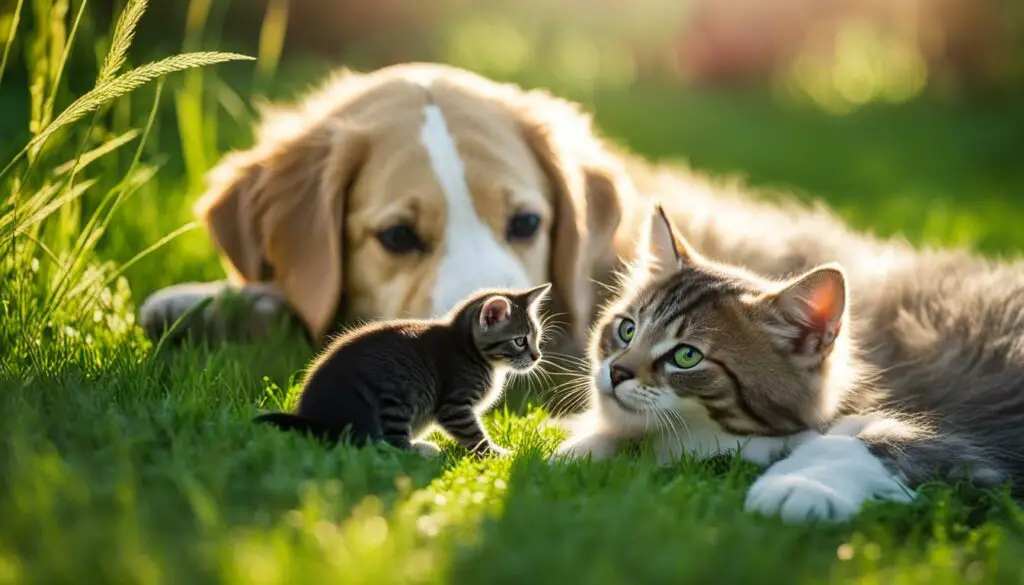
Take it slow and don’t force it

Introducing a new kitten to your dog requires patience and a gradual approach. Rushing the process can lead to unnecessary stress and potential conflicts between the two pets. It’s important to take it slow and allow them to adjust to each other at their own pace.
Start by allowing the kitten and dog to become familiar with each other’s scents. You can do this by placing their bedding or toys in each other’s spaces. This will help them associate the scent with a positive experience. Be sure to supervise this step to ensure there are no signs of aggression or fear.
Next, you can move on to controlled visual introductions. Keep the kitten in a carrier or on a leash, and let the dog approach slowly. Observe their body language and reactions. If they seem comfortable, you can gradually increase their interaction time.
Throughout the process, it’s important to provide a safe space for the kitten to retreat to if they feel overwhelmed. This can be a separate room or a designated area with their food, water, litter box, and toys. It’s also essential to monitor their interactions closely and intervene if needed. Remember, every pet is unique, and the introduction process may take longer for some than others. Patience and positive reinforcement are key to a successful integration between your kitten and dog.
Considerations for a Safe and Appropriate Family Dynamic
When introducing a new cat or dog to your household, it’s essential to consider the safety and compatibility factors to ensure a harmonious family dynamic. Not all dogs are suitable for living with cats, so it’s crucial to assess their behavior and compatibility beforehand. Taking the time to plan and gradually introduce your pets can help create a positive environment where everyone feels safe and minimizes stress.
To evaluate compatibility, observe both your dog’s and the potential cat’s behavior around other animals. Some dogs have a strong prey drive, which may not be compatible with a cat’s presence. It’s important to gauge your dog’s reaction to small animals, such as squirrels or birds, as this can indicate their likelihood of accepting a cat in the household. If your dog has a history of aggression or territorial behavior, it might be challenging to create a safe environment for a cat.
Additionally, consider the temperament and sociability of the cat you plan to introduce. Some cats are more adaptable and can easily integrate into a multi-pet household, while others may be more solitary and prefer to be the only pet. By understanding the characteristics and needs of both your dog and the new cat, you can make an informed decision about their compatibility.
Remember, even with careful planning and introductions, there is no guarantee that cats and dogs will become best friends. It’s essential to prioritize the safety and well-being of both pets. If they show signs of stress, aggression, or fear, it may be necessary to consult with a professional animal behaviorist or trainer who can provide guidance and support to ensure a successful integration.

Table: Dog and Cat Compatibility Factors
| Compatibility Factors | Considerations |
|---|---|
| Sociability | Determine if your dog and cat have been socialized with other animals and are comfortable in their presence. |
| Prey Drive | Assess your dog’s prey drive and determine if they are likely to view a cat as prey. |
| Temperament | Consider the temperament of both your dog and cat, as some personalities may be more likely to clash. |
| Past Behavior | Reflect on any past interactions your dog or cat has had with other animals and how they responded. |
| Size and Energy Levels | Take into account the size and energy levels of your dog and cat, as a large, highly active dog may intimidate a small, timid cat. |
Preparing Your Home for a New Cat or Kitten
When bringing a new cat or kitten into your home, it’s essential to create a safe and welcoming environment. By making a few preparations, you can help ensure a smooth transition for your new furry friend and existing pets. Here are some tips to help you prepare your home for the arrival of a new cat or kitten.
Create a Cat’s Safe Space
Every cat needs a designated safe space where they can retreat and feel secure. Set up a room or area in your home specifically for your new cat or kitten. This should include a comfortable bed or blanket, a litter box, food and water dishes, and some toys. This space will give your cat a sense of security and help them adjust to their new surroundings at their own pace.
Introduce Existing Pets Gradually
If you already have pets in your home, it’s crucial to introduce them to your new cat or kitten gradually. Keep the new cat separated in their safe space initially and allow them to get used to each other’s scents. This can be done by swapping bedding or using a pheromone diffuser to create a calming atmosphere. Over time, you can slowly introduce the pets to each other in a controlled and supervised manner.
Provide Vertical Spaces
Cats love to climb and perch in high places, so it’s important to provide vertical spaces in your home for them. Install cat trees, shelves, or dedicated climbing areas where your cat can explore and relax. This not only provides physical exercise but also gives your cat a sense of territory and security.
Conclusion
Preparing your home for a new cat or kitten involves creating a safe and welcoming space, introducing pets gradually, and providing vertical spaces for your feline friend. By taking these steps, you can help ease the transition and create a harmonious environment for both your new cat and existing pets.
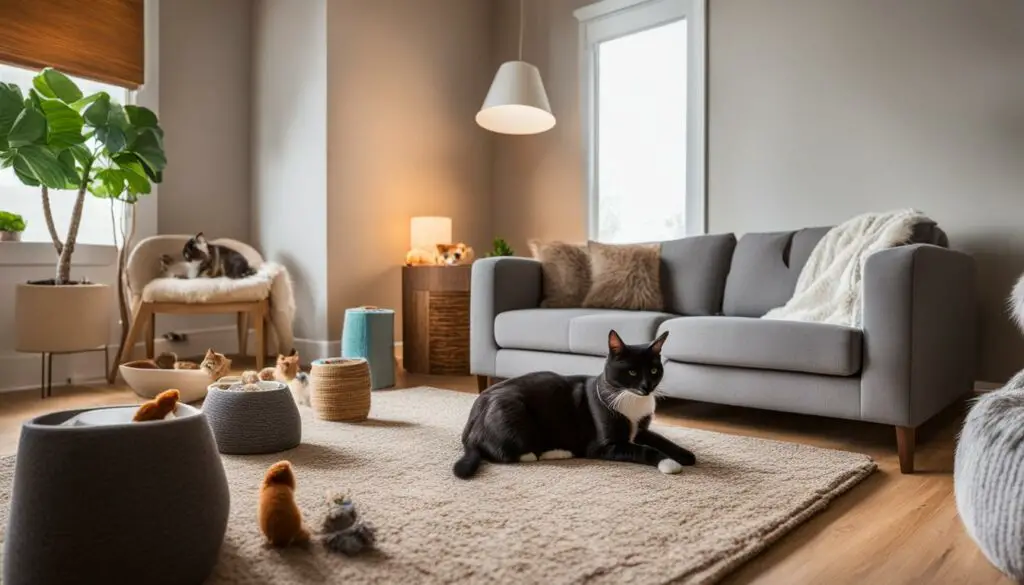
Gradual Introduction Process
Introducing a cat to a dog requires a gradual and carefully managed process to ensure a smooth transition. By following these steps, you can help foster positive interactions between your pets.
1. Set up a safe space: Create a separate room for your new cat with all the essentials, including a litter box, food, and water. Allow the cat to become familiar with this space before introducing them to the rest of the house or your dog. This will help them feel secure and establish their own territory.
2. Scent familiarization: Before allowing direct contact, let your cat and dog get used to each other’s scents. You can do this by swapping blankets or feeding them on opposite sides of a closed door. This allows them to become familiar with each other’s scent, reducing the chances of a negative reaction when they finally meet face to face.
3. Controlled introductions: The initial meeting between your cat and dog should be carefully supervised. Keep the cat in a carrier or on a leash, and ensure the dog is calm and under control. Allow them to observe each other from a safe distance, rewarding calm behavior with treats and praise. Gradually increase the duration of these supervised interactions as they become more comfortable with each other.
| Step | Description |
|---|---|
| 1 | Set up a safe space for the cat |
| 2 | Allow scent familiarization |
| 3 | Controlled introductions with supervision |
Remember, every cat and dog is unique, and the introduction process may take time. Patience and consistency are key. If either pet displays signs of fear or aggression, take a step back and reintroduce them at a slower pace. Seek professional guidance if needed. With gradual introductions, your cat and dog can develop a harmonious relationship over time.
Introduction techniques and milestones
Introducing a new cat to a resident dog can be a delicate process that requires patience and careful planning. By following the right techniques and milestones, you can help create a positive and harmonious relationship between your cat and dog. Let’s explore some effective strategies to ensure a successful introduction.
1. Visual introductions through a barrier
Start the introduction process by allowing your cat and dog to see each other without direct contact. Use a baby gate or a screen door to create a physical barrier between them. This allows them to observe and become familiar with each other’s presence without feeling threatened. Gradually increase the amount of time they spend together in this way, monitoring their reactions closely.
2. Short supervised sessions without a barrier
Once your cat and dog have become accustomed to each other’s presence, you can progress to supervised sessions without a barrier. Keep your dog on a leash during these interactions to ensure control and avoid any potential mishaps. Allow them to approach each other at their own pace, rewarding calm and positive behavior with treats and praise. If either animal shows signs of stress or aggression, separate them and try again later.
3. Gradually increase the duration
As your cat and dog become more comfortable and relaxed with each other, gradually increase the duration of their supervised interactions. This helps them build trust and develop positive associations with each other’s presence. Remember to always provide a safe space for your cat to retreat to if they feel overwhelmed. Consistency, patience, and positive reinforcement are key during this gradual integration process.
Remember that every cat and dog is unique, and the introduction process may vary in duration and intensity. Some cats and dogs may become fast friends, while others may need more time to adjust. It’s important to observe their body language and behavior throughout the entire process to ensure their well-being and happiness.

By following these techniques and milestones, you can lay the foundation for a peaceful and harmonious relationship between your cat and dog. Keep in mind that the process may have its ups and downs, but with patience and understanding, you can help them establish a strong bond that will enrich their lives and bring joy to your household.
Introducing a Kitten to a Puppy: Nurturing a New Friendship
Introducing a kitten to a puppy can be an exciting and heartwarming experience, but it’s important to take the necessary precautions to ensure a smooth transition for both furry friends. With careful management and supervision, you can foster a harmonious relationship between your new kitten and puppy. Here are some tips to help you navigate this delicate introduction process.
Gradual Introduction
When introducing a kitten to a puppy, it’s crucial to take things slowly. Allow them to get used to each other’s presence before allowing direct interaction. Start by keeping them in separate rooms and gradually introduce their scents to one another. This can be done by swapping bedding or using a blanket to collect their individual scents. This helps them become familiar with each other’s smell without the pressure of direct contact.
Supervised and Controlled Interactions
Once they are comfortable with each other’s scents, you can proceed to supervised and controlled interactions. This can be done through a barrier, such as a baby gate, to ensure their safety. Allow the kitten and puppy to see each other without physical contact. Positive reinforcement is key during this stage. Reward both pets with treats and praise for calm and friendly behavior. It’s crucial to closely monitor their body language and intervene immediately if any signs of aggression or fear arise.
Time and Patience
Building a strong bond between a kitten and a puppy takes time and patience. It’s essential not to rush the process and allow them to set their own pace. Avoid forcing them to interact or spend too much time together initially. Gradually increase the duration of their interactions as their comfort level grows. Remember, each animal is unique, and their individual personalities will play a role in how quickly they adapt to each other.
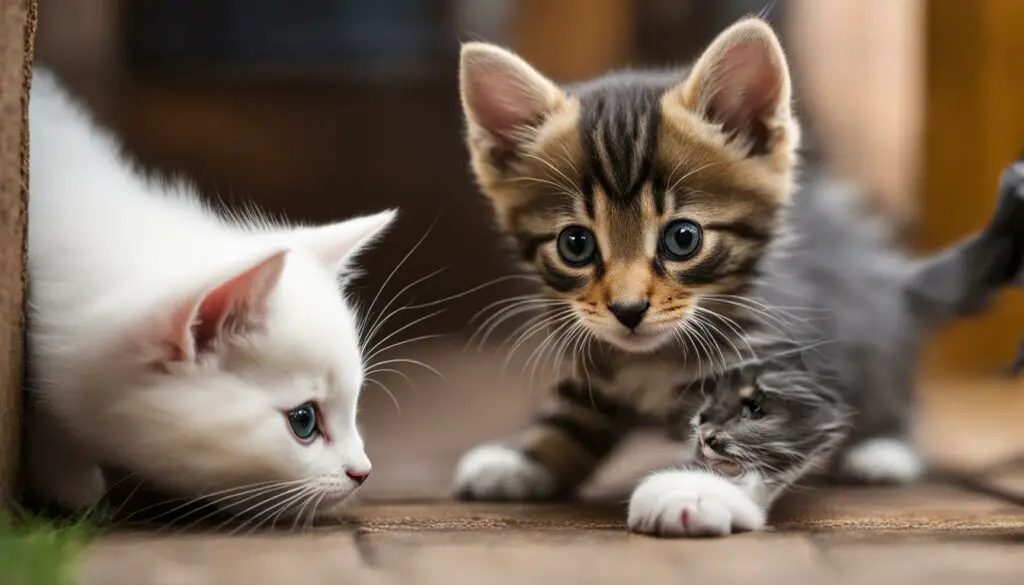
By following these guidelines and providing them with a safe and controlled environment, you can help nurture a positive and lasting friendship between your new kitten and puppy. Remember to always prioritize their safety and well-being throughout the introduction process. With time, patience, and a little bit of love, your furry friends will soon become inseparable companions.
Conclusion
I hope this guide has been helpful in your journey to successfully introduce a kitten to your dog. By following the step-by-step instructions and taking the time to prepare both your dog and the environment, you can create a harmonious relationship between your furry friends.
Remember, patience is key. It may take some time for your pets to adjust and feel comfortable around each other. Be vigilant and monitor their interactions, rewarding positive behavior with praise and cuddles. And never punish either animal for any aggressive behavior.
Creating a safe and appropriate family dynamic is crucial. Assess your dog’s behavior and compatibility with cats before introducing a new feline companion. Planning and gradual introductions will help ensure that everyone feels safe and minimize stress.
Lastly, seek professional help if needed. If you’re facing difficulties or have any concerns during the introduction process, consult a veterinarian or a professional animal behaviorist. They can provide valuable guidance and support to help your kitten and dog build a strong and harmonious bond.
FAQ
What should I do to prepare my dog for the arrival of a new kitten?
It’s important to give your dog lots of attention and praise to show that the new kitten is not a threat. Never leave them alone together in the early days, as dogs can potentially harm or even kill a kitten.
How can I create a safe space for my new kitten?
It’s recommended to prepare a separate room with a bed, litter box, and food and water. Let the kitten explore this space on their own before introducing them to the rest of the house or your dog.
How can I help the kitten and dog get used to each other’s scents?
You can feed them on either side of a closed door or swap their blankets to introduce their scents. Supervise this process and ensure your dog doesn’t exhibit intimidating behavior towards the kitten.
How should I manage the first meeting between the kitten and dog?
Keep the kitten in a box and the dog on a leash to prevent physical contact. Make the dog sit and remove them from the room if they become too excited. Repeat this process until both animals can relax when together.
When can I let the kitten out of the box during the introduction process?
Once the kitten and dog are comfortable being in the same room, you can start allowing the cat out of the box while keeping the dog on a leash. Repeat this process several times a day until the dog can relax when the kitten is exploring.
When can I let the dog off the leash during the introduction process?
When your dog can remain calm while the kitten is in the room, you can start allowing them off the leash. This stage may take weeks, so be patient. It’s advisable to keep them separated when you’re not around to monitor the situation.
What should I do if the introduction process is not going well?
Don’t rush the process and be prepared to separate them if necessary. It’s better to be safe than sorry. Keep them separated when you’re not around to monitor the situation. Successful introductions may take longer than expected.
How should I prepare my home for a new cat or kitten?
Set up high resting places for the new cat to retreat to and ensure they have a separate space with all their necessities. This will reduce stress and facilitate a smooth transition.
What is the gradual introduction process for a cat and dog?
Start by allowing the cat to settle into their new environment and become comfortable with you. Gradually expose them to each other’s scents and supervise their interactions. Patience is key, as success may take time.
How should I introduce a kitten to a puppy?
Supervise their interactions to prevent any potential harm to the kitten. If the puppy has a strong prey drive, additional management measures may be necessary. Separate introductions may be needed for each dog if you have multiple pets.
How can I ensure a harmonious relationship between my kitten and dog?
Successfully introducing a kitten to a dog requires careful preparation, gradual introductions, and patience. Prioritize safety and monitor their interactions until you are certain they can tolerate each other. Seek professional help if needed and never punish either animal for aggressive behavior.








